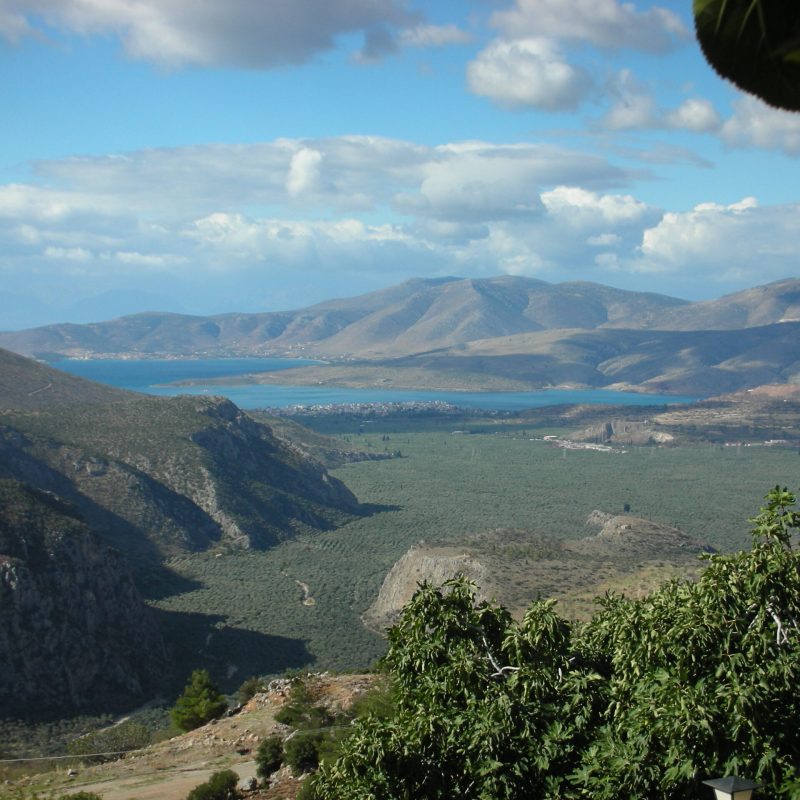
Think of Greece and the Greek islands and long summer days spent on sandy beaches with glorious swimming opportunities surely spring to mind. We’ve also seen, however, that Greece can be enjoyed in the winter, yet during my 15-year tenure in this diverse country, spring has become my favorite time in Greece, not least because it’s still a season that isn’t yet overrun with tourists.
Videos by TravelAwaits
Whilst it’s certainly not a hot time of year, perhaps precluding those beach days, the average temperature in Greece during spring is between 57 and 81 degrees Fahrenheit, rarely falling below 47 degrees Fahrenheit. With wildflowers in bloom, nature unfurling, between 6 and 9 hours of sunlight each day, and the winter finally bidding goodbye, I hope to whet your appetite to come and explore, offering you these 8 reasons to visit Greece in the spring.
1. The Ancient Castle Town Of Monemvasia
Located in the southeast Peloponnese region of mainland Greece, Monemvasia is a breathtaking ancient castle town carved into the slopes of a huge rock jutting out to sea, only accessible by a single causeway from the mainland or viewed from the sea if out on a boat trip.
Deliberately designed in this way to be invisible from the mainland to invading enemies, the result is a culmination of ancient paved streets, old mansions converted into boutique hotels and guesthouses, churches, and the castle perched atop, keeping a watchful eye.
Just opposite the rock on the mainland, a New Town has been developed with more guesthouses and many traditional tavernas, but still sympathetic to and combining successfully with the ancient surrounds.
At just 3 hours and 45 mins from Athens (322 kilometers/200 miles), it’s possible to visit Monemvasia for a day trip, but come in the spring when the tourists have not gathered yet and enjoy a weekend break in this unusual destination.

2. Visit Greece’s Original Capital City: Nafplion
Sticking with the Peloponnese, Nafplion is a coastal town, a mere 2-hour drive or bus trip from Athens on the eastern side of the peninsula, making it a perfect weekend getaway to explore the many sights and stroll the bougainvillea-lined cobbled streets in the spring.
Originally the capital city of the newly formed Greek state — between 1823 and 1834 — the Old Town has a special atmosphere, with grand mansions and large squares where locals gather to drink their coffees and while away the day.
Fortified by the Venetians in 1493, sights include the Bourtzi Fortress — located on a small island just outside the harbor of Nafplion and used as a residence for the executioner of Prisoners of War in 1821, then a hotel between 1930 and 1970. It’s possible to take a boat trip out to the fortress, especially beautiful at sunset.
Other attractions such as the Palamidi Fortress sit on a hill overlooking the town. With eight preserved bastions, the chapel of Agios Andreas was built within the center and used as a place to house prisoners of the War of the Revolution. A visit to the Fortress is recommended for sweeping views across the Bay and town. Be warned! There are 999 steps to climb up to the fortress.
Nafplion is popular year-round, especially with Greeks due to its proximity to Athens and location by the sea. But for me, spring is the best time, perfect for sitting and soaking up the atmosphere outside a promenade cafe with the sun on my face.
Treat yourself to a stay at the nearby Opora Country Living, the perfect rustic lodge experience to base yourself in when in the region, and perfect to experience in spring.

3. Nafpaktos
Another trademark Venetian town, Nafpaktos sits in the west of the mainland, opposite the Peloponnese.
Oozing discreet medieval charm with its castle at the top of the town offering unparalleled views across to the Peloponnese and surrounding mountains, the tiny port is protected by traditional stone walls and towers. Plus, there are several statues of historical significance around the town, which is within 2 hours and 20 minutes from Athens, making it a perfect haven to venture out and enjoy in spring.
Aside from the small town itself, part of the joy of visiting Nafpaktos is the journey. To reach it from Athens, the quickest route takes you over the Corinth Canal from the mainland to the Peloponnese — a sight in itself. The route later doubles back over the Gulf of Corinth via the impressive Rio-Antirrio Bridge — one of the world’s longest multi-span cable bridges.
My advice? Don’t drive over the bridge. Take the small car ferry to reach Nafpaktos as you gain a much better perspective of this impressive infrastructure against its surroundings.

4. The Ancient Village Of Nymfaio
Straight out of a fairytale, the Macedonian town of Nymfaio in the northwestern mainland is a restored, traditional aristocratic mountain village, built using traditional stone from the area and situated at an altitude of 1m35 meters (4,429 feet).
Originally one of the richest villages in the region, it declined starting in the 1950s as people moved away for work reasons, but from the 1980s onward, a few descendants from the region began to take pride again and revived their village, the result being that UNESCO has now singled it out as being one of the top ten most picturesque villages in Europe.
Although a popular winter destination, spring is perfect to come to Nymfaio and walk the ancient streets, take in the grandeur of the traditional houses, hike through the surrounding woodland trails, or simply sit in one of the many bistros that were once traditional kafinas — coffee shops.
Local food of the region includes trahanosoupa — a grain-based soup — and traditional pies.
Pro Tip: Nymfaio is a long 6.5 hours from Athens by car, so fly either to Thessaloniki, from which the drive is a more manageable 2 hours, or fly to the tiny lakeside town of Kastoria — an area of natural beauty and a mere hour and 15 minutes away.

5. The Arcturos Bear And Wolf Sanctuary
Aside from the beauty of the ancient village of Nymfaio, another reason to visit this region is the Arcturos Bear and Wolf Sanctuary.
Founded in 1992 and spread out over an enclosed area of 24 acres, initially, the sanctuary was set up to rescue the dancing bears, as seen across many Balkan states. Brown bears can also be found, occasionally, in the wild in Greece yet as infrastructure developed, their habitat was threatened by deforestation and many bears were killed by vehicles hitting them, leaving the young orphaned. Arcturos as been a literal lifesaver for these bears — a place where they can live out their days amongst nature.
The name Arcturos stems from a combination of the Ancient Greek arktos, meaning “bear.” and arcturus, meaning “Guardian of the Bear.”
It’s one of the most important features of the village, with spring being the perfect time to visit as the bears come out of hibernation.

A few kilometers away is the Wolf Sanctuary, where rescued wolves (from zoos and illegal pet possession) are hosted in a 17-acre oak forest. Harder to spot, a visit to the Wolf Sanctuary is definitely a must.
As of 2021 Arcturos also hosts lynx, rescued from a wildlife sanctuary in Andorra that had to close.

6. Ancient Delphi
The Oracle of Delphi is considered one of the most important archaeological sites in Greece. Held in very high esteem in Ancient Greece, pilgrims from across the Mediterranean would travel to Delphi to understand the prophecies of the ancient God Apollo, delivered by his high-priestess Pythia.
Scientists have also confirmed that Delphi is “the navel” — the absolute central point of the earth, and according to many who visit, this accounts for its special energy.
Whether you believe in said energy or not, the site itself is beautiful to visit in the spring, which is the perfect time to walk among its many ancient relics, including the Temple of Apollo, the Ancient Theatre, the ancient stadium used to host the games of those times, and the Sanctuary of Athena Pronea.
Nestled against the backdrop of Mount Parnassus and surrounded by pine trees and olive groves with views as far down to the seaside town of Galaxidi and only a 2 hour and 15-minute car or bus journey from Athens, Ancient Delphi is a must-visit.

7. The UNESCO Monasteries Of Meteora
Meteora is a must-visit for any visitor to Greece, whether you’re religious or not.
There are a total of six Byzantine monasteries still intact here, seemingly floating in the sky above ancient pinnacles formed thousands of years ago in the Pindus Mountain Range in the northwestern part of the Greek mainland.
Built in the 14th century to protect hermit monks from the Ottoman invaders, there were originally 26 monasteries, and of the six still remaining, five operate for monks while one is for nuns. Some areas are open to the public, and there are many relics and frescoes inside.
Many visit Meteora not just for its religious tourism, but also for the nature and hiking opportunities the place presents.
Fun fact: Fans of the James Bond film For Your Eyes Only may recognize the Holy Trinity Monastery, which was featured in the end scene.

8. Athens Itself
Spring is the perfect opportunity to spend time in the city. It’s not too hot, so you’ll enjoy ideal conditions for visiting the famous sites, climbing the Acropolis hill to the Parthenon, wandering the quaint “island” streets of Anafiotika, and seeing the changing of the guards outside Parliament. See my tips for 9 Fantastic Things To Do In Athens for additional inspiration.
Spring is also the perfect time of the year to experience the Athens Riviera, before it gets too busy, and take a dip in Lake Vouliagmeni.
Any time of the year is great to visit Greece, but spring’s my favorite.

